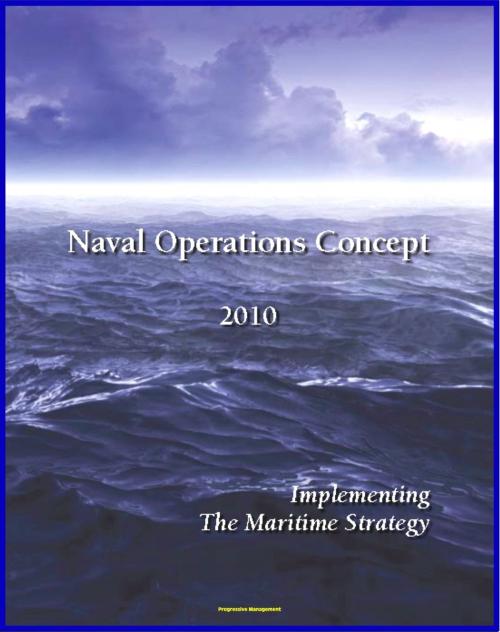Naval Operations Concept 2010: Maritime Security, Power Projection, Force Structure, Seapower Strategy for Navy, Marines, and Coast Guard
Nonfiction, Science & Nature, Technology, Military Science, Social & Cultural Studies, Political Science, Government| Author: | Progressive Management | ISBN: | 9781458110510 |
| Publisher: | Progressive Management | Publication: | June 2, 2011 |
| Imprint: | Smashwords Edition | Language: | English |
| Author: | Progressive Management |
| ISBN: | 9781458110510 |
| Publisher: | Progressive Management |
| Publication: | June 2, 2011 |
| Imprint: | Smashwords Edition |
| Language: | English |
Naval Operations Concept 2010 (NOC 10) describes when, where and how U.S. naval forces will contribute to preventing conflict and prevailing in war in order to guide Maritime Strategy implementation in a manner consistent with national strategy. NOC 10 describes the ways in which the sea services will achieve the ends articulated in A Cooperative Strategy for 21st Century Seapower (CS-21), signed by the Chief of Naval Operations, Commandant of the Marine Corps and Commandant of the Coast Guard in October 2007. NOC 10 is not designed for a cursory reading; it is a publication intended for serious study by professionals. Readers will quickly discern several themes that collectively embody the essence of naval service to our Nation. Implicit in these themes is that Sailors, Marines, and Coast Guardsmen should expect to be engaged in both preventing and winning wars. These themes reflect the content of CS-21 as well as the guidance provided by the Secretary of Defense in the National Defense Strategy (NDS) and the 2010 Quadrennial Defense Review (QDR).
The sea services have a long history of accomplishing diverse missions, from protecting American merchantmen during an undeclared naval war in the late 18th century, to establishing our naval prowess in the War of 1812, to suppressing the African slave trade and West Indian piracy in the 19th century, to fighting the major wars and confronting the irregular challenges of the 20th century. As the 21st century unfolds, we must continue to be effective warriors as well as informed and articulate ambassadors, serving our Nation’s interests and facilitating free global interaction from the sea.
Contents include: Introduction, The Naval Service, The Overarching Concept, Maneuver Space, Forward Presence, Maritime Security, Humanitarian Assistance and Disaster Response, Sea Control, Power Projection, Deterrence, Future Force Structure.
Continuous innovation, by the United States, its allies and partners, and its adversaries, compels NOC 10 to be a contemporary document that guides current operations, as well as a forward looking effort to anticipate and describe the ways new capabilities can be integrated into joint force efforts to address emerging threats. In this regard, NOC 10 articulates how naval capabilities can be applied in support of the combatant commanders’ operations, contingency plans, and theater security cooperation (TSC) plans.
The integration of naval capabilities to achieve specific joint mission objectives is the responsibility of commanders, who formulate their concepts of operations to achieve advantage and decision. In contrast, Service operational concepts are designed to describe the capabilities that operational commanders can expect the Services to provide, and indicate selected ways these capabilities can be integrated to achieve mission success. Consequently, NOC 10 is designed to inform development of joint concepts, plans and experimentation.
NOC 10 articulates the ways naval forces are employed to achieve the strategy conveyed in CS-21. Published in 2007, CS-21 described a set of core capabilities that added maritime security and humanitarian assistance and disaster response (HA/DR) to the traditional forward presence, deterrence, sea control, and power projection. Not to be viewed as discrete missions or functions, these core capabilities are intrinsically linked and mutually supporting enablers for achieving the Naval Service’s strategic imperatives: Regionally concentrated, credible combat power to: Limit regional conflict with deployed, decisive maritime power; Deter major power war; Win our Nation’s wars. Globally distributed, mission-tailored maritime forces to: Contribute to homeland defense in depth; Foster and sustain cooperative relationships with more international partners; Prevent or contain local disruptions before they impact the global system.
Naval Operations Concept 2010 (NOC 10) describes when, where and how U.S. naval forces will contribute to preventing conflict and prevailing in war in order to guide Maritime Strategy implementation in a manner consistent with national strategy. NOC 10 describes the ways in which the sea services will achieve the ends articulated in A Cooperative Strategy for 21st Century Seapower (CS-21), signed by the Chief of Naval Operations, Commandant of the Marine Corps and Commandant of the Coast Guard in October 2007. NOC 10 is not designed for a cursory reading; it is a publication intended for serious study by professionals. Readers will quickly discern several themes that collectively embody the essence of naval service to our Nation. Implicit in these themes is that Sailors, Marines, and Coast Guardsmen should expect to be engaged in both preventing and winning wars. These themes reflect the content of CS-21 as well as the guidance provided by the Secretary of Defense in the National Defense Strategy (NDS) and the 2010 Quadrennial Defense Review (QDR).
The sea services have a long history of accomplishing diverse missions, from protecting American merchantmen during an undeclared naval war in the late 18th century, to establishing our naval prowess in the War of 1812, to suppressing the African slave trade and West Indian piracy in the 19th century, to fighting the major wars and confronting the irregular challenges of the 20th century. As the 21st century unfolds, we must continue to be effective warriors as well as informed and articulate ambassadors, serving our Nation’s interests and facilitating free global interaction from the sea.
Contents include: Introduction, The Naval Service, The Overarching Concept, Maneuver Space, Forward Presence, Maritime Security, Humanitarian Assistance and Disaster Response, Sea Control, Power Projection, Deterrence, Future Force Structure.
Continuous innovation, by the United States, its allies and partners, and its adversaries, compels NOC 10 to be a contemporary document that guides current operations, as well as a forward looking effort to anticipate and describe the ways new capabilities can be integrated into joint force efforts to address emerging threats. In this regard, NOC 10 articulates how naval capabilities can be applied in support of the combatant commanders’ operations, contingency plans, and theater security cooperation (TSC) plans.
The integration of naval capabilities to achieve specific joint mission objectives is the responsibility of commanders, who formulate their concepts of operations to achieve advantage and decision. In contrast, Service operational concepts are designed to describe the capabilities that operational commanders can expect the Services to provide, and indicate selected ways these capabilities can be integrated to achieve mission success. Consequently, NOC 10 is designed to inform development of joint concepts, plans and experimentation.
NOC 10 articulates the ways naval forces are employed to achieve the strategy conveyed in CS-21. Published in 2007, CS-21 described a set of core capabilities that added maritime security and humanitarian assistance and disaster response (HA/DR) to the traditional forward presence, deterrence, sea control, and power projection. Not to be viewed as discrete missions or functions, these core capabilities are intrinsically linked and mutually supporting enablers for achieving the Naval Service’s strategic imperatives: Regionally concentrated, credible combat power to: Limit regional conflict with deployed, decisive maritime power; Deter major power war; Win our Nation’s wars. Globally distributed, mission-tailored maritime forces to: Contribute to homeland defense in depth; Foster and sustain cooperative relationships with more international partners; Prevent or contain local disruptions before they impact the global system.















